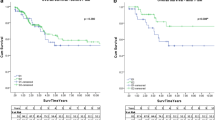Abstract
Background
This study was conducted to evaluate the leaning curve of D2 lymph node dissection for patients with gastric cancer in a high-volume center.
Methods
The authors prospectively reviewed the data of all patients who underwent total gastrectomy with D2 lymph node dissection during a 4-year period. Retrieved lymph node number was used as a surrogate marker of oncological outcome. The retrieved lymph node number cut-off value required for satisfactory D2 lymph node dissection was defined as >25. Cumulative sum analysis was used to examine the learning curves of individual surgeons at target accuracy rates of 85%, 90%, 92.5%, 95%, and 98%.
Results
Two junior staff surgeons performed 198 curative-intent total gastrectomies with D2 lymph node dissections during the study period; their success rates exceeded 90%. Operating time decreased with operative experience (Pearson correlation coefficient = −0.515, P < 0.001). The learning period for total gastrectomy with D2 lymph node dissection for these two junior members of staff was calculated as 23–35 cases, presuming a 92.5% success rate.
Conclusions
The current study suggests that the surgical learning period for D2 lymph node dissection extends to at least 23 cases or 8 months. In clinical trials containing gastric cancer surgery, the learning curve for qualified surgery from the standpoint of oncological outcome should be considered to minimize bias due to surgeon-associated factors.


Similar content being viewed by others
References
Kim JP. Surgical results in gastric cancer. Semin Surg Oncol 1999; 17:132–8
Shin HR, Ahn YO, Bae JM, et al. Cancer incidence in Korea. Cancer Res Treat 2002; 34:405–08
Schwarz RE, Smith DD. Extended lymph node dissection for gastric cancer: who may benefit? Final results of the randomized Dutch Gastric Cancer Group trial. J Clin Oncol 2005; 10:5404–05
Brennan MF. Lymph node dissection for gastric cancer. N Engl J Med 1999; 340:956–7
Yoo CH, Noh SH, Shin DW, et al. Recurrence following curative resection for gastric carcinoma. Br J Surg 2000; 87:236–42
Bonenkamp JJ, Hermans J, Sasako M, et al. Extended lymph-node dissection for gastric cancer. Dutch Gastric Cancer Group. N Engl J Med 1999; 340:908–14
Cuschieri A, Fayers P, Fielding J, et al. Postoperative morbidity and mortality after D1 and D2 resections for gastric cancer: preliminary results of the MRC Randomised Controlled Surgical Trial. The Surgical Cooperative Group. Lancet 1996; 347:995–9
Macdonald JS, Smalley SR, Benedetti J, et al. Chemoradiotherapy after surgery compared with surgery alone for adenocarcinoma of the stomach or gastroesophageal junction. N Engl J Med 2001; 345:725–30
Stocchi L, Nelson H, Sargent DJ, et al. Impact of surgical and pathologic variables in rectal cancer: a United States community and cooperative group report. J Clin Oncol 2001; 15:3895–902
Japanese Research Society for Gastric Cancer. Japanese Classification of Gastric Carcinoma. Tokyo: Kanehara, 1–71, 1995
Sobin LH, Wittenkind C. International Union Against Cancer (UICC) TNM Classification of Malignant Tumours, 5th ed. New York: Wiley-Liss, pp 59–62, 1997
Tekkis PP, Senagore AJ, Delaney CP, et al. Evaluation of the learning curve in laparoscopic colorectal surgery: comparison of right-sided and left-sided resections. Ann Surg 2005; 242:83–91
Parikh D, Johnson M, Chagla L, et al. D2 gastrectomy: lessons from a prospective audit of the learning curve. Br J Surg 1996; 83:1595–9
Wagner PK, Ramaswamy A, Ruschoff J, et al. Lymph node counts in the upper abdomen: anatomical basis for lymphadenectomy in gastric cancer. Br J Surg 1991; 78:825–7
Siewert JR, Bottcher K, Stein HJ, et al. Relevant prognostic factors in gastric cancer: ten-year results of the German Gastric Cancer Study. Ann Surg 1998; 228:449–61
Callahan MA, Christos PJ, Gold HT, et al. Influence of surgical subspecialty training on in-hospital mortality for gastrectomy and colectomy patients. Ann Surg 2003; 238:629–36
O’Connor GT, Plume SK, Olmstead EM, et al. A regional intervention to improve the hospital mortality associated with coronary artery bypass graft surgery. The Northern New England Cardiovascular Disease Study Group. JAMA 1996; 20:841–6
Hillner BE, Smith TJ, Desch CE. Hospital and physician volume or specialization and outcomes in cancer treatment: importance in quality of cancer care. J Clin Oncol 2000; 18:2327–40
Feinstein AR, Sosin DM, Wells CK. The Will Rogers phenomenon: stage migration and new diagnostic techniques as a source of misleading statistics for survival in cancer. N Engl J Med 1985; 20:1604–08
Dahr DK, Kubota H, Tachbana M, et al. Body mass index determines the success of lymph node dissection and predicts the outcomes of gastric carcinoma patients. Oncology 2000; 59:18–23
Author information
Authors and Affiliations
Corresponding author
Rights and permissions
About this article
Cite this article
Lee, J.H., Ryu, K.W., Lee, JH. et al. Learning Curve for Total Gastrectomy with D2 Lymph Node Dissection: Cumulative Sum Analysis for Qualified Surgery. Ann Surg Oncol 13, 1175–1181 (2006). https://doi.org/10.1245/s10434-006-9050-8
Received:
Accepted:
Published:
Issue Date:
DOI: https://doi.org/10.1245/s10434-006-9050-8




